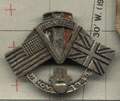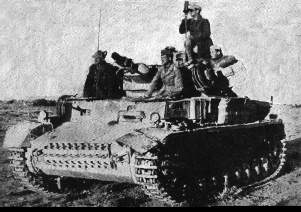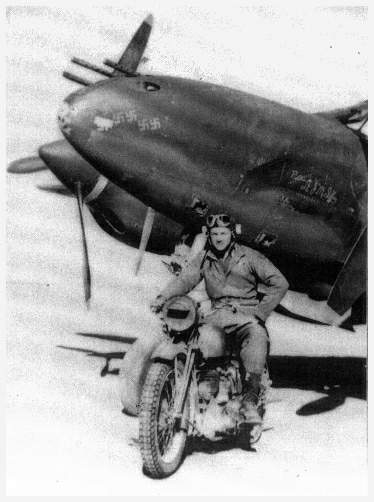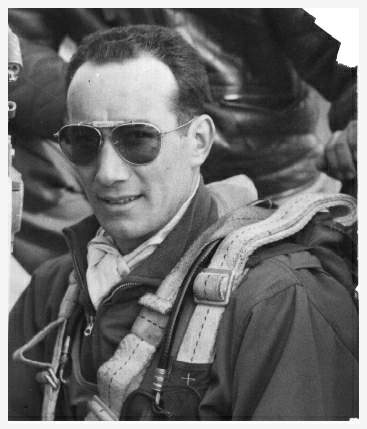|
 The 1ST.FG IN OPERATION TORCH
The 1ST.FG IN OPERATION TORCH
'THE FIRST DESERT STORM'
 A newspaper proclaiming the beginning of Operation Torch. (Courtesy of the USAF Museum)  A pin commemorating Operation Torch created in the combat zone. The three flags represent the nations involved in the Operation, US, France and Great Britain. (From a private collection in Canada.)  A Panzer Tank from Rommel's North Africa Corps, these became frequent targets for strafing Allied aircraft. (From the collection of The Art of Syd Edwards) (From LIFE magazine, 16 August, 1943) "The immediate purpose of the invasion, is to protect French North Africa against the menace of an Italo-German invasion. The principal aim is the annihilation of the enemy and the complete liberation of invaded France. The sovereignty of France over French territories remains complete. All together, we will get them." -- Lt. General Dwight D. Eisenhower, Commander-in-Chief of the American Expeditionary Forces. (From a leaflet dropped over Oran and Casablanca on midnight, November 8,1942)  Capt. Jack Ilfrey on a captured German motorcycle. "They didn't run long but they sure did run!" (Photograph courtesy of Col. Jack Ilfrey)  Col. Glenn Hubbard, CO of the 94th.FS digging his own foxhole. (Photograph courtesy of Jack Ilfrey) |
|
� � The mission of Operation Torch was: 1.) The establishment of firm and mutually supported footholds (a) between Oran and Tunisia on the Mediterranean, and (b) in French Morocco on the Atlantic, in order to secure bases for continued and intensified air, ground and sea operations. 2.) Exploitation of the footholds in order to acquire complete control of French Morocco, Algeria, and Tunisia and extend offensive operations against the rear of Axis forces eastward.� 3.) Destroy the Axis forces now opposing the British forces in the Western Desert and establish bases for the intensification of air and sea operations against the Axis in the European continent.* � � Sometimes refered to as "The Little Known War," Operation Torch was the name given to the Allied invasion of North Africa in 1942. This operation signaled the end of German/Italian dominance over the skies of Africa. Caught in a vise-like grip which quickly compressed over the area of Tunisia, the Axis air forces faced the lastest aerial weapons the Allies could produce, The P-51 Mustang, the Spitfire MkIX and the P-38 Lightning. � � In November, 1942 the men of the 1st., 14th. and 87th. Fighter Groups prepared for a long mission. Even as the tranport aircraft left they were unaware of their exact destination. Speculation ran high and many believed that they were about to be shipped back to the Zone of Interior. The ground crews were told of their destination as the passed the Straits of Gibraltar. � � On the night of 8 November, the pilots of the 1st.FG were called in by Group C.O. Col. John Shaw and briefed on their mission for the following day. They were to be part of the (then) largest Allied invasion force, their new bases would be in Algeria. The men studied maps and memorized the route until late in the evening. � � The next morning they had breakfast then climbed into their P-38s and headed out with their ships filled to over flowing with gasoline. Two external tanks were mounted underneath each wing, both containing an additional 150 gallons. � � "We took off from England, flew nine hours and fifteen minutes with a Martin B-26 as a mother ship to guide us. Sitting that long strapped in the seat of a P-38 is bad enough. But in this flight an even worse strain was not knowing whether we would have to shoot our way into the airfield at Oran where we were going to land. Fortunately, the field had surrendered to our troops..." -- Capt. Newell Roberts, 94th.FS* � � The 1st.FG arrived in Tafaroui, Algeria having only lost one 27th.FS pilot over the Atlantic and two 94th.FS pilots (Squadron CO Capt. James Harmon and Lt. Jack Ilfrey,) who had made emergency landings in Portugal. Both Harmon and Ilfey later rejoined their squadron at a later time. � � On 20 November the three squadrons dispersed to airfields behind the front, the 71st. moved to Maison Blanche, the 94th. to Youks-les-Bains and the 27th., along with the Group HQ in Navion. While this provided a larger area of coverage it also made the already poor supply situation worsen. � � The going was not easy for the Allied airmen and their crews. The men of the 1st. Fighter Group shared little more than a whole big enough for two men to lay in, covered by a puptent. Toilet facilities consisted of holes dug into the ground which were open to the elements. Any shelter was constructed from the empty five-gallon gas cans aircrews used to refill the P-38s, which had then been filled with earth and stacked one atop the other. Supplies of even critically needed aircraft (there were only 1,123 P-38s in the USAAF inventory in Dec.,1942,) aircraft parts and food were nearly non-existant. Meals, for both the enlisted men and officers, were served in the open as well. For the first few days the pilots had to act as their own ground crews, working an additional six or eight hours a night cleaning and loading their guns and filling their aircraft with gasoline from those five-gallon gas cans, which was a lenghty job, to say the least. � � Capt. Roberts: " ...For the first week in Africa, I lived on chocolate bars and emergency rations. Something had happened to our supplies. I landed in Africa weighing 175 pounds and left four months later weighing 135..."** � � Lt. Ilfrey, of the 94th.FS described the conditions: "...When the rains came -- nothing but mud and mud. When the winds came -- nothing but blowing sand, which greatly affected the operations of our P-38s. Later, when we moved near Constantine we found nothing but cold weather."*** � � The 94th.FS made the group's first combat sorties in North Africa on 29 November when six aircraft strafed a German airfield at Gabes. Capt. Roberts and Lt. Ilfrey shared in the downing of a Me-110 and later that same day other squadron members downed two Ju-88s and claimed two Me-109s as probables. Click to hear then Lt. Jack Ilfrey recount a victory over an Me-110
� � By 1 December the ground crews had finally caught up to the air echelon and things settled into as much of a routine as possible. Their arrival was "greated with great cheers from the pilots." Indeed they could not have arrived at a better time as the remainder of the year the Group spent in combat or moving from base to base. The 94th. joined the 71st. at Maison Blanche on Decmeber 11th., but just days later the entire group was moved to a new base at Biskra. |

A meeting of cultures. Note "Texas Terror" in background with skull and crossbones on nose.
BACK TO THE BIO � BACK TO THE 1ST.FG
(*- From "History of United States Naval Operations In World War II, Vol. II; Operations In North African Waters, Oct. 1942 - June 1943" by: Samuel Eliot Morison; pub: Little, Brown and Company, Boston, 1960, -**"Three Seconds To Fight", Collier's, 8 Sept., 1943, ***- From "Happy Jack's Go Buggy".)
Unless otherwise noted, all content � copyright The Art of Syd Edwards 1998,1999. All rights reserved and reproduction is prohibited.
